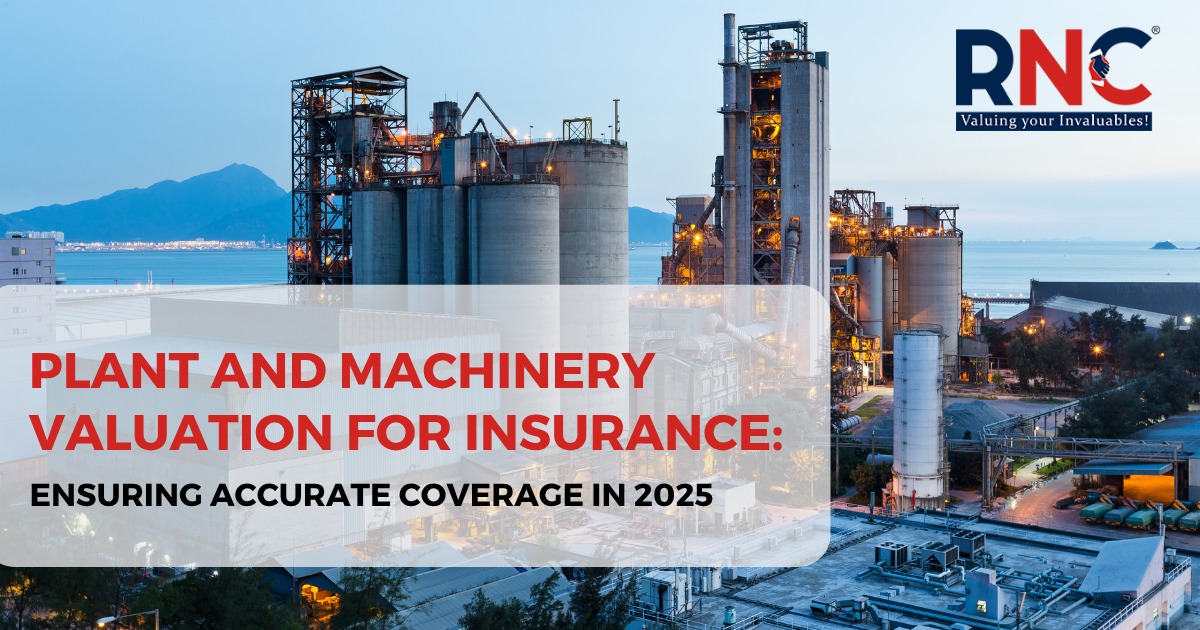
In today’s dynamic business environment, ensuring that your Plant and Machinery Valuation assets are accurately valued for insurance purposes is more critical than ever. The right valuation helps you secure adequate coverage, avoid underinsurance risks, and safeguard your investments.
With rising costs of equipment and evolving insurer expectations in 2025, many businesses face challenges in keeping their asset valuations current. This makes professional plant and machinery valuation an essential component of your risk management strategy.
Accurate valuation not only ensures smoother claim settlements but also helps optimize your premium costs. It provides clarity to both insurers and insured parties, building trust and transparency in your insurance coverage.
At RNC Valuecon LLp, we bring decades of experience in conducting comprehensive valuation for insurance, combining regulatory expertise with in-depth asset knowledge. We aim to empower businesses with accurate and dependable valuation solutions that ensure complete confidence in their insurance coverage.
Read more : Valuation for Insurance Purposes: Importance and Methodologies
In this guide, we’ll walk you through why plant and machinery valuation matters for insurance, how the process works, and what key trends you should be aware of in 2025. Whether you’re renewing your policy, expanding operations, or seeking expert valuation support — this blog will help you make informed decisions.
Why Accurate Plant and Machinery Valuation Matters for Insurance
Accurate plant and machinery valuation is the foundation of sound insurance coverage. Without a precise understanding of your assets’ value, you risk facing serious financial gaps during a claim or paying unnecessarily high premiums.
Risks of Underinsurance / Over insurance
Underinsurance occurs when your machinery is valued below its true replacement cost. In the event of a loss, your claim payout may fall short, forcing your business to cover the remaining expense out of pocket. It could cause business valuation interruptions, increased financial pressure, and slower restoration efforts.
Over insurance, on the other hand, leads to higher premiums without providing any additional benefit. You end up paying more than necessary for coverage that exceeds your actual exposure — money that could be better allocated elsewhere.
A professionally conducted valuation for insurance ensures that your plant and machinery are insured at the right value — no more, no less.
How Proper Valuation Improves Claims Outcomes
When a claim is filed, insurers rely on the documented value of your insured assets to determine payout eligibility. If your valuation is outdated, inaccurate, or poorly documented, disputes can arise — delaying settlements or reducing claim amounts.
Conversely, an up-to-date, expert-backed valuation:
- Speeds up claim processing
- Reduces disputes with insurers
- Increases the likelihood of full and fair compensation
It also enhances transparency between your business and the insurer, fostering trust and facilitating smoother policy renewals
Understanding Plant and Machinery Valuation for Insurance Coverage
A clear understanding of how plant and machinery valuation works ensures that your business stays fully protected under its insurance coverage. Let’s break it down:
What is Plant and Machinery Valuation?
- Definition: It refers to assessing the appropriate worth of industrial assets, including equipment and machinery, specifically for the purpose of securing insurance coverage.
- Purpose: To establish a value that accurately reflects the cost of replacing or repairing the insured assets.
- Scope: Covers a wide range of assets — production machinery, tools, vehicles, utilities, and even specialized equipment.
- Valuation for Insurance vs. Business Valuation:
- Insurance valuation focuses on replacement cost or current depreciated value.
- Business valuation looks at overall company worth, including goodwill, revenue, and market positioning.
When is Valuation Needed for Insurance?
- New policy creation: When setting up an insurance policy for newly acquired assets.
- Policy renewal: To ensure valuations reflect current asset values (essential with today’s inflation and supply chain costs).
- Following equipment enhancements or alterations to reflect changes in performance or worth.
- Regulatory requirements: Some industries mandate periodic plant & machinery valuation for compliance.
- Following a claim: To adjust the valuation post-repair or replacement.
- Business events: Mergers, acquisitions, or restructuring activities often trigger the need for updated valuations.
Replacement Cost vs. Actual Cash Value
- Replacement Cost (RC):
- Represents the amount needed to purchase or build a new equivalent asset at today’s prices.
- Most preferred for insurance, as it ensures full replacement of lost assets.
- Adjusted for inflation and current market rates.
- Actual Cash Value (ACV):
- Reflects the replacement cost minus depreciation for age, wear and tear.This may hinder business continuity, put financial resources under pressure, and slow down the recovery process.
- Results in lower claim payouts but lower premiums.
- Often used when insuring older equipment or in certain industry policies.
- Choosing the Right Approach:
- High-value critical assets → Replacement Cost is recommended.
- Older, non-essential equipment → Actual Cash Value may suffice.
How Plant and Machinery Valuation is Done for Insurance
A precise valuation process ensures that your plant and machinery valuation for insurance reflects the true worth of your assets helping avoid disputes and ensuring optimal coverage. Here’s how expert valuers approach it:
Step-by-Step Valuation Process
- Initial Consultation
- Understand the scope and purpose of the valuation.
- Define whether the client needs valuation for insurance, business valuation, or both.
- Asset Identification
- Develop a comprehensive list documenting each item of machinery and equipment.
- Identify movable, immovable, and leased equipment.
- Physical Inspection
- Conduct on-site verification of the equipment.
- Record make, model, serial number, capacity, condition, and usage history.
- Perform physical verification of plant and equipment.
- Data Collection
- Collect invoices, past valuation reports, repair records, and maintenance logs.
- Gather market data on replacement costs and industry trends.
- Application of Valuation Methods (explained in next section)
- Select appropriate valuation approach based on equipment type, usage, and client’s insurance requirements.
- Preparation of Valuation Report
- Prepare a comprehensive report documenting the assessed value of plant and machinery.
- The document outlines the chosen valuation method—such as replacement cost or depreciated value along with underlyng assumptions, scope boundaries, and formal validation..
- Review with Client & Insurer
- Share the assessment outcomes with company executives and the insurance provider.
- Support insurance underwriting or policy renewal process.
Read more : plant & equipment valuation
Valuation Methods Used
Depending on asset type and insurance requirement, valuers apply one or a combination of these methods:
- Cost Approach
- Calculates Replacement Cost New (RCN) and deducts depreciation.
- Most commonly used method in valuation for insurance.
- Market Approach
- Compares asset to recent sales of similar equipment.
- Useful for assets with an active secondary market.
- Income Approach
- Evaluates how much the equipment is worth by analyzing its future earning capacity.
- Less commonly used for insurance, but relevant in business valuation for revenue-linked assets.
- Residual Value Analysis
- Used when equipment is close to completing its serviceable duration.
- Helps insurers decide whether ACV (Actual Cash Value) is more appropriate.
Common Challenges and How to Avoid Them
- Incomplete Asset Register
- Solution: Conduct thorough physical verification of plant and equipment and cross-check with accounting records.
- Outdated or Inaccurate Data
- Solution: Update valuations regularly to reflect current replacement costs, factoring in inflation and market dynamics.
- Ignoring Depreciation Impact
- Solution: Apply correct depreciation rates and consult equipment experts where needed.
- Lack of Documentation
- Solution: Maintain complete purchase records, maintenance logs, and valuation reports to support the claim process.
- Choosing the Wrong Valuation Basis
- Solution: Consult valuation experts to select between Replacement Cost and Actual Cash Value, based on asset type and policy terms.
Industry Trends for 2025: Insurance & Valuation Landscape
The valuation for insurance landscape is evolving rapidly in 2025. Businesses must stay informed about key trends to ensure their plant and machinery valuation remains accurate and aligned with insurer expectations.
Here’s what you need to know:
Inflation & Replacement Cost Trends
- Rising replacement costs: Global supply chain challenges and increased material costs have led to a sharp rise in equipment replacement costs.
- Impact on insurance coverage: If your valuation isn’t updated regularly, you risk being underinsured. This gap could result in significant financial exposure during a claim.
- Recommendation: Update your valuation of equipment at least annually to reflect current market conditions.
New Technologies in Valuation
- 3D scanning & digital inspections: Many valuers now use advanced technologies such as 3D scanning to accurately capture machinery dimensions and conditions.
- AI-powered market analysis: Some firms leverage AI to analyze historical and current market data, improving valuation accuracy.
- Benefits: Faster, more reliable valuations; better documentation for insurers; enhanced business valuation insights.
Evolving Insurance Expectations
- Greater scrutiny on valuation reports: Insurers are demanding more detailed and transparent valuation reports to justify coverage amounts.
- Shift towards Replacement Cost-based policies: In 2025, insurers increasingly prefer Replacement Cost as the valuation basis to avoid disputes.
- Focus on compliance & regulatory alignment: Valuation reports must meet regulatory standards and align with insurers’ internal underwriting guidelines.
Conclusion
In 2025, accurate plant and machinery valuation for insurance is essential to avoid underinsurance risks and ensure smoother claim settlements. With rising asset costs and evolving insurer expectations, relying on outdated values can leave your business exposed. An expert-conducted valuation helps safeguard your assets while enhancing trust with insurance providers.
At RNC Valuecon LLP., we bring decades of experience in valuation for insurance, business valuation, and valuation of equipment — backed by regulatory expertise and modern tools.
Ready to secure your coverage with confidence? Contact us today to schedule your valuation.
FAQs
1. How often should plant and machinery be valued for insurance?
Annually for inflationary periods; otherwise every 18–24 months or when major assets are added, upgraded, or relocated.
2. What is the right basis—RCN or Market Value?
For insurance, RCN (Replacement Cost New) + incidentals is standard to avoid underinsurance; market value can understate true reinstatement cost.
3. What details should be in the valuation report?
Asset description, make/model, year, capacity, location, RCN, depreciation approach (if applicable), and inclusions like freight, duties, and erection & commissioning.
4. How does valuation reduce claim disputes?
It aligns the Sum Insured to current replacement cost, preventing average‑clause deductions and supporting faster, better‑documented settlements.

About the author:
Sahil Narula
Sahil Narula is the Managing Partner at RNC Valuecon LLP and a Registered Valuer with IBBI. He brings over a decade of experience in Valuation Services, Corporate Finance, and Advisory, having led numerous complex assignments under the Insolvency & Bankruptcy Code, 2016, Mergers & Acquisitions, Insurance, and Financial Reporting.
He is a regular speaker at national forums (ASSOCHAM, CII, ICAI, IBBI, Legal Era) and currently serves as Co-Chairman of ASSOCHAM’s National Council on Insolvency & Valuations and a member of CII’s Task Force on Insolvency & Bankruptcy.
🤝Connect with Sahil on LinkedIn.
